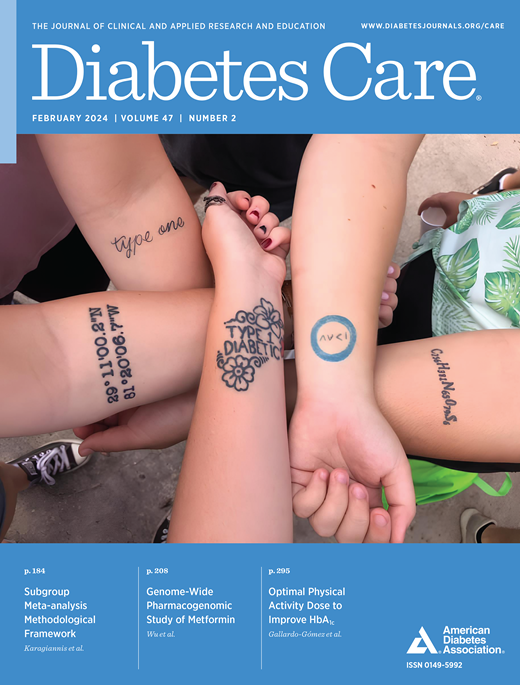Low-Carbohydrate Diets of Varying Macronutrient Quality and Risk of Type 2 Diabetes in Three U.S. Prospective Cohort Studies
IF 16.6
1区 医学
Q1 ENDOCRINOLOGY & METABOLISM
引用次数: 0
Abstract
OBJECTIVE To prospectively examine associations between five low-carbohydrate diets (LCDs), differentiated by macronutrient quality, and type 2 diabetes (T2D) risk. RESEARCH DESIGN AND METHODS This cohort study included 199,006 U.S. adults from the Nurses’ Health Study (NHS) (1984–2018), NHSII (1991–2019), and Health Professionals Follow-up Study (1986–2018); free of T2D, cardiovascular disease, and cancer at baseline; and followed over 30 years. Diet was assessed every 2–4 years using validated food frequency questionnaires since baseline. Five LCD scores were derived based on intakes of protein, fat, and carbohydrates from contrasting food sources. The primary outcome was incident T2D. RESULTS During 4,987,761 person-years of follow-up, 20,452 T2D cases were documented. After adjustments for baseline BMI and other covariates, higher overall LCD score was associated with higher T2D risk (hazard ratio comparing highest vs. lowest quintile 1.31 [95% CI 1.25–1.37]; P-trend < 0.001). An animal-based LCD emphasizing animal protein and fat and an unhealthy LCD score further deemphasizing whole grains and other high-quality carbohydrates were associated with higher T2D risk (1.39 [1.32–1.45] and 1.44 [1.37–1.51]; both P-trend < 0.001). In contrast, a vegetable-based LCD emphasizing plant protein and fat was associated with a 6% lower T2D risk (0.94 [0.90–0.98]; P-trend = 0.004), and a healthy LCD further deemphasizing refined carbohydrates was associated with a 16% lower T2D risk (0.84 [0.81–0.88]; P-trend < 0.001]). Associations for overall, animal-based, and unhealthy LCDs were stronger among participants with lower baseline BMI and were partially mediated by weight change. CONCLUSIONS LCDs may not be beneficial for primary prevention of T2D unless they prioritize plant-based protein, healthy fats, and high-quality carbohydrates.美国三项前瞻性队列研究:不同常量营养素质量的低碳水化合物饮食与2型糖尿病的风险
目的前瞻性研究五种低碳水化合物饮食(lcd)与2型糖尿病(T2D)风险之间的关系。研究设计和方法本队列研究包括199006名美国成年人,分别来自护士健康研究(NHS)(1984-2018)、国家护士健康研究(NHSII)(1991-2019)和卫生专业人员随访研究(1986-2018);基线时无T2D、心血管疾病和癌症;30多年来一直如此。从基线开始,每2-4年使用有效的食物频率问卷对饮食进行评估。五个LCD分数是根据不同食物来源的蛋白质、脂肪和碳水化合物的摄入量得出的。主要结局为T2D事件。结果在4,987,761人年的随访中,记录了20,452例T2D病例。在调整基线BMI和其他协变量后,较高的总体LCD评分与较高的T2D风险相关(最高五分位数与最低五分位数的风险比为1.31 [95% CI 1.25-1.37]; P-trend < 0.001)。以动物为基础的LCD强调动物蛋白和脂肪,而不健康的LCD评分进一步不强调全谷物和其他优质碳水化合物,与较高的T2D风险相关(1.39[1.32-1.45]和1.44 [1.37-1.51],p趋势均为&;lt; 0.001)。相比之下,以蔬菜为基础的LCD强调植物蛋白和脂肪,与T2D风险降低6%相关(0.94 [0.90-0.98];p趋势= 0.004),而健康的LCD进一步不强调精制碳水化合物,与T2D风险降低16%相关(0.84 [0.81-0.88];p趋势&;lt; 0.001])。在基线BMI较低的参与者中,总体、动物性和不健康lcd的关联更强,并且部分由体重变化介导。结论:除非优先考虑植物蛋白、健康脂肪和高质量碳水化合物,否则lcd可能不利于T2D的一级预防。
本文章由计算机程序翻译,如有差异,请以英文原文为准。
求助全文
约1分钟内获得全文
求助全文
来源期刊

Diabetes Care
医学-内分泌学与代谢
CiteScore
27.80
自引率
4.90%
发文量
449
审稿时长
1 months
期刊介绍:
The journal's overarching mission can be captured by the simple word "Care," reflecting its commitment to enhancing patient well-being. Diabetes Care aims to support better patient care by addressing the comprehensive needs of healthcare professionals dedicated to managing diabetes.
Diabetes Care serves as a valuable resource for healthcare practitioners, aiming to advance knowledge, foster research, and improve diabetes management. The journal publishes original research across various categories, including Clinical Care, Education, Nutrition, Psychosocial Research, Epidemiology, Health Services Research, Emerging Treatments and Technologies, Pathophysiology, Complications, and Cardiovascular and Metabolic Risk. Additionally, Diabetes Care features ADA statements, consensus reports, review articles, letters to the editor, and health/medical news, appealing to a diverse audience of physicians, researchers, psychologists, educators, and other healthcare professionals.
 求助内容:
求助内容: 应助结果提醒方式:
应助结果提醒方式:


